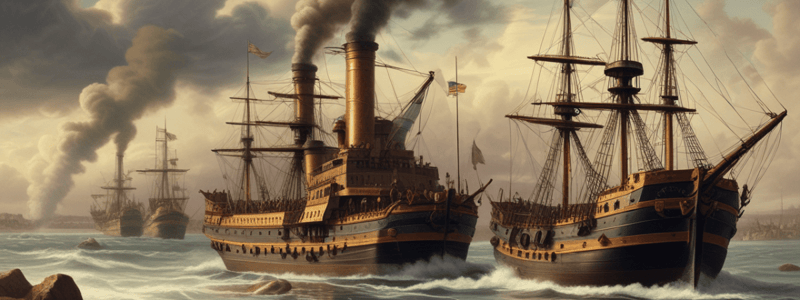Podcast
Questions and Answers
What was the unifying factor that brought Americans together despite their geographical differences?
What was the unifying factor that brought Americans together despite their geographical differences?
- European migration
- Industrialization
- Self-governance (correct)
- Westward expansion
Which group benefited the most from the spread of democracy during the early 19th century?
Which group benefited the most from the spread of democracy during the early 19th century?
- Women
- European immigrants
- White men (correct)
- African Americans
What was the primary consequence of urbanization and European migration during the early 19th century?
What was the primary consequence of urbanization and European migration during the early 19th century?
- Social tensions and class divides (correct)
- Decreased economic inequality
- Improved communication between urban and rural areas
- Increased social cohesion
What was the primary factor that drove the geographical distance between urban dwellers and frontier settlers?
What was the primary factor that drove the geographical distance between urban dwellers and frontier settlers?
What were the two technological innovations mentioned in the text that maintained communication between urban and rural areas?
What were the two technological innovations mentioned in the text that maintained communication between urban and rural areas?
Flashcards are hidden until you start studying
Study Notes
Early 19th Century United States
- The early 19th century was a period of immense change in the United States, marked by economic, political, demographic, and territorial transformations.
- These transformations radically altered how Americans thought about themselves, their communities, and the rapidly expanding nation.
- The period was characterized by great optimism, with the possibilities of self-governance influencing various aspects of life, including religion and politics.
Conflicts and Inequality
- The benefits of industrialization and democratization were unevenly distributed along lines of gender, race, and class.
- Westward expansion created a growing divide between urban dwellers and frontier settlers.
- Despite this, technological innovations like the telegraph and railroads offered new ways to maintain communication.
Democracy and Social Tensions
- The spread of democracy led to the expansion of the franchise to nearly all white men.
- Urbanization and a large influx of European migration led to increased social tensions and class divides.
- These changes contributed to a complex and conflicted society in the early 19th century United States.
Studying That Suits You
Use AI to generate personalized quizzes and flashcards to suit your learning preferences.




